0969ss12
0969ss12.docx
Final Authorization for Hazardous Waste Management Programs (Renewal)
OMB: 2050-0041
SUPPORTING STATEMENT FOR
INFORMATION COLLECTION REQUEST OMB CONTROL NO.2050-0041
"FINAL AUTHORIZATION FOR
HAZARDOUS WASTE MANAGEMENT PROGRAMS"
TABLE OF CONTENTS
1. Identification of the Information Collection
1(a) Title and Number of the Information Collection 2
1(b) Short Characterization 2
2. Need for and Use of the Collection
2(a) Need and Authority for the Collection 5
2(b) Use and Users of the Data 6
3. Nonduplication, Consultations, and Other Collection Criteria
3(a) Nonduplication 7
3(b) Public Notice 7
3(c) Consultations 7
3(d) Effects of Less Frequent Collection 7
3(e) General Guidelines 8
3(f) Confidentiality 8
3(g) Sensitive Questions 9
4. The Respondents and the Information Requested
4(a) Respondents .9
4(b) Information Requested 9
5. The Information Collected -- Agency Activities, Collection Methodology, and
Information Management
5(a) Agency Activities 19
5(b) Collection Methodology and Management 21
5(c) Small Entity Flexibility 21
5(d) Collection Schedule 22
6. Estimating the Burden and Cost of Collection
6(a) Estimating Respondent Burden 23
6(b) Estimating Respondent Costs 23
6(c) Estimating Agency Burden and Costs 24
6(d) Bottom Line Burden Hours and Costs 24
6(e) Reasons for Change in Burden 25
6(f) Burden Statement 25
EXHIBITS 27-33
1. IDENTIFICATION OF THE INFORMATION COLLECTION
1(a) TITLE AND NUMBER OF THE INFORMATION COLLECTION
This ICR is titled "Final Authorization for Hazardous Waste Management Programs (Renewal)," ICR number 0969.12, OMB number 2050-0041.
1(b) SHORT CHARACTERIZATION
Section 3006(a) of the 1976 Resource Conservation and Recovery Act (RCRA) authorizes EPA to develop guidelines to assist States in developing State hazardous waste programs. 40 CFR Part 271 subpart A specifies the requirements that States and territories must follow in developing and revising their RCRA Subtitle C programs. It also establishes procedures EPA must follow in approving, revising, and withdrawing approval of State programs. The substantive provisions which must be included in State programs for them to be approved include requirements for permitting, compliance evaluation, enforcement, public participation, and sharing of information. State programs must adopt or enforce requirements that are at least as stringent as those required under this subpart. There is nothing that precludes a State from adopting or enforcing requirements that are more stringent or extensive.
2. NEED FOR AND USE OF THE COLLECTION
2(a) NEED AND AUTHORITY FOR THE COLLECTION
RCRA, as amended by Hazardous and Solid Waste Amendments of 1984 (HSWA), provides for authorization of State hazardous waste programs. To achieve final authorization, a State must demonstrate that its program meets the statutory tests embodied in the regulatory requirements for final authorization in 40 CFR Part 271, Subpart A. These statutory tests or standards for State programs are:
(1) State Program Authorization: Base Program Development
• They must be "equivalent" to the Federal program (RCRA Section 3006(b));
• They may not impose any requirements "less stringent" than the Federal requirements (RCRA Section 3009);
• They must be "consistent" with the Federal program and other authorized State programs (RCRA Section 3006(b));
• They may, however, impose requirements which are "more stringent" than those imposed by Federal regulations (RCRA Section 3009); and
• They must "provide adequate enforcement" of compliance with the program (RCRA Section 7004(b)).
(2) State Program Authorization: Base Program Public Participation and Submission
• They must follow specific procedures for public "notice and hearing" in the permitting process (RCRA Section 7004(b)); and
• They must provide for the public availability of information "in substantially the same manner and to the same degree" as the Federal program (RCRA Section 3006(f)).
(3) State Program Authorization: Revision Applications
• They must follow strict deadlines in revising their programs, as required by section 271.21.
(4) State Program Authorization: Withdrawal
• The information collected from the States during the application process for State authorization allows EPA to make a determination of whether the State program meets the statutory requirements listed above. If EPA determines that the State program does not meet these criteria, EPA may start procedures for withdrawing approval of the program, in accordance with section 271.23.
RCRA Section 3006(g) also provides for interim authorization for requirements promulgated pursuant to HSWA. A State may receive interim authorization if its program is substantially equivalent to the Federal program. EPA does not expect to receive any applications for interim authorization, because States that need to amend their regulations for HSWA authorization will amend them in a manner that will allow them to qualify for final authorization. Interim authorization will be an unnecessary step. Thus, this ICR addresses only the information requirements necessary to obtain final authorization.
2(b) USE AND USERS OF DATA
In order for a State to obtain final authorization for a State hazardous waste program, it must submit an official application to EPA for review. The State's application must address all provisions of the Federal program that were in effect one year prior to application submission (see 40 CFR 271.21(e)). Therefore, it is important for any State initially applying for final authorization to adopt any Federal program change that occurred earlier than the date one year before its official application is submitted.
If the State also has equivalent authority for Federal program elements that became effective less than a year prior to the State's application, then the State's application may include demonstration of such authority so that EPA will also be able to confer authorization for those program elements. However, it is important to note that the State is not required to have a counterpart to any Federal provision that became effective during that time period in order to receive initial authorization, although the State will subsequently need to modify its program for such changes as part of the program revision process.
EPA will use the information submitted by the State in order to determine whether the State's program meets the statutory requirements for authorization. Specifically, EPA will:
• Determine the scope, structure, coverage, and processes of the State program;
• Determine whether the State has the capability to carry out the proposed program;
• Determine whether the State has existing authority (both statutory and regulatory) that is equivalent to the Federal Subtitle C regulatory program addressing generator standards; transporter standards; and treatment, storage, or disposal facility (TSDF) permitting requirements and procedures;
• Determine whether the State has identified existing deficiencies in its hazardous waste program and the means and schedule for correcting these deficiencies in order to become eligible for program authorization in a timely manner; and
• Negotiate the memorandum of Agreement (MOA) between the State and EPA which delineates State and EPA responsibilities and coordination in program administration, enforcement and compliance monitoring, and facility permitting.
3. NONDUPLICATION, CONSULTATIONS, AND OTHER COLLECTION CRITERIA
3(a) NONDUPLICATION
No other Federal agency collects State hazardous waste program information -- State authorization for hazardous waste management programs is a responsibility of EPA. EPA has noted, however, that States seeking a program revision may meet this information requirement by simply updating and amending their previously submitted final authorization program packages to address changes in program scope, available resources, permit administration and enforcement activities, the legislative base for the program modification, and any amendments made to the States regulations since the State received final authorization. Also, 40 CFR Part 271 requires no duplication of effort at the State level, for all previously submitted data or legislative information can be incorporated by reference into the application package. All information and data compiled and reported as elements of a State's annual RCRA grant application may also be used in the authorization application process. This information may be incorporated by reference or simply copied and included as appendices to the State authorization submittal.
3(b) PUBLIC NOTICE
In compliance with the Paperwork Reduction Act (44 U.S.C. 3501 et seq.), the Agency issued a notice in the Federal Register on September 28, 2021, soliciting public comments on the accuracy of the burden estimates in this supporting statement (86 FR 53655). The Agency received one comment, which was outside the scope of this ICR.
3(c) CONSULTATIONS
Several States were consulted over the burden estimates covered in this ICR. The consultants who responded felt the burden estimates for this ICR are accurate.
3(d) EFFECTS OF LESS FREQUENT COLLECTION
EPA has amended the requirements for revisions of authorized State hazardous waste programs to provide for less frequent submission of authorization applications for program revisions. Clustering Federal program changes on an annual basis (or multi-year basis for HSWA) allows States to amend their regulations and submit applications annually, rather than in a more frequent piecemeal fashion. In addition, EPA has provided a streamlined procedure for minor or routine rules. This procedure decreases the requirement for Attorney Generals statements, Program Descriptions and the Memorandum of Agreement. Minor or routine rules encompass those RCRA program revisions which do not increase the scope or authority of the State program, and include technical corrections, and additions to rules previously authorized (e.g. waste listings).
3(e) GENERAL GUIDELINES
The Federal requirements governing the content of State final authorization applications are contained in 40 CFR 271 Subpart A. A State's initial application for final authorization must contain the following elements as required by §271.5(a):
Governor's Letter requesting approval of the State program;
Program Description explaining the program the State proposes to administer together with any forms to be used to administer the program under State law;
Statement from the State Attorney General (or the attorney for those State agencies which have independent legal counsel) declaring that the laws of the State do provide adequate authority to carry out the program the State proposes to administer;
Memorandum of Agreement providing for coordination and cooperation between the State and EPA regarding the administration and enforcement of the authorized State regulatory program as part of the national hazardous waste management program;
Copies of all applicable State statutes and regulations including those governing State administrative procedures; and
Documentation of public participation activities (i.e., notice and opportunities for comment on the State program prior to submission of the application to EPA).
Once authorized, a State is obligated to maintain equivalence to the Federal program in order to retain its authorization (40 CFR 271.21(e)). As EPA amends the Federal RCRA program, States with final authorization must similarly revise their programs and apply for authorization for those revisions. The documentation required for program revisions have been significantly reduced through improved standardized models, but will vary, depending on the scope of the State modifications and previously submitted application materials.
3(f) CONFIDENTIALITY
This section is not applicable, since no confidential information is required to be submitted by the States. All information collected under 40 CFR Part 271 from respondent States is made available to the general public through public notice and hearings. The authorization applications are available to be viewed at any time in the State or EPA program office.
3(g) SENSITIVE QUESTIONS
Information required of States seeking final authorization or program revisions under 40 CFR Part 271 will not involve questions of a sensitive nature.
4. THE RESPONDENTS AND THE INFORMATION REQUESTED
4(a) RESPONDENTS
The fifty (50) States and eight (8) territories of the United States (States) will be affected by the authorization requirements discussed in this ICR.
4(b) INFORMATION REQUESTED
(1) State Program Authorization: Base Program Development
(a) Miscellaneous Program Elements
Section 271.5(a) and (c) describes the requirements for any State that is preparing a RCRA Subtitle C program under this part. Any State that seeks to administer a program must obtain a letter from the Governor requesting program approval and prepare copies of all applicable State statutes and regulations, pursuant to section 271.5(a)(1) and (5), respectively. In addition, if the State's submission is materially changed during EPA review, the State will provide a revised version to EPA, as required by section 271.5(c).
(i) Data items:
• A letter from the Governor of the State requesting program approval;
• Copies of all applicable State statutes and regulations, including those governing State administrative procedures; and
• A revised submission in accordance with §271.5(c), if the State's submission is materially changed during EPA review.
(ii) Respondent activities:
To comply with the requirements of section 271.5, States must perform the following activities:
• Read the regulations;
• Obtain a letter from the Governor requesting program approval, as required by §271.5(a)(1);
• Prepare copies of all applicable State statutes and regulations, including those governing State administrative procedures, as required by §271.5(a)(5); and
• Revise its submission, as required by §271.5(c), in the event that the State's submission is materially changed during EPA review.
(b) Program Description
Any State that seeks to administer a program under Part 271 Subpart A shall prepare a description of the program it proposes to administer in lieu of the Federal program under State law or under an interstate compact, as required by section 271.6.
(i) Data items:
The program description shall contain the following:
• A description in narrative form of the scope, structure, coverage, and processes of the State program;
• A description of the organization and structure of the State agency or agencies which will have responsibility for administering the program, including the information listed below:
-- A description of the State agency staff who will carry out the State program, including the number, occupations, and general duties of the employees;
-- An itemization of the estimated costs of establishing and administering the program, including cost of the personnel, administrative support, and technical support; and
-- An itemization of the sources and amounts of funding, including an estimate of Federal grant money, identifying any restrictions or limitations upon this funding.
• A description of applicable State procedures, including permitting procedures and any State administrative or judicial review procedures;
• Copies of the permit form(s), application form(s), and reporting form(s) the State intends to employ in its program. The State need not provide copies of uniform national forms it intends to use, but should note its intention to use such forms;
• A complete description of the State's tracking and enforcement program;
• A description of the State manifest tracking system, and of the procedures the State will use to coordinate information with other approved State programs and the Federal program regarding interstate and international shipments;
• An estimate of the number of generators, transporters, and treatment, storage, and disposal facilities, and a brief description of the types of facilities and an indication of the permit status of these facilities; and
• If available, an estimate of the annual quantities of hazardous wastes generated within the State; transported into and out of the State; and stored, treated, or disposed of within the State: On-site; and Off-site.
(ii) Respondent activities:
To comply with the requirements of section 271.6, States must perform the following activities:
• Read the regulations; and
• Prepare a program description, as required by §271.6.
(c) Attorney General's Statement
Any State that seeks to administer a program under Part 271 Subpart A shall obtain a statement from the State Attorney General that the laws of the State provide adequate authority to carry out the program described under section 271.6 and to meet the requirements of this subpart, as required by section 271.7.
(i) Data items:
• Attorney General's statement, including citations to the specific statutes, administrative regulations, and where appropriate, judicial decisions which demonstrate adequate authority.
(ii) Respondent activities:
To comply with the requirements of section 271.7, States must perform the following activities:
• Read the regulations; and
• Prepare a statement by the State Attorney General, as required by §271.7.
(d) Memorandum of Agreement with EPA
Any State that seeks to administer a program under Part 271 Subpart A shall prepare a Memorandum of Agreement (MOA), as required by section 271.8.
(i) Data items:
MOA shall include the following terms:
• Provisions for EPA to forward to the State information obtained prior to program approval in notifications provided under section 3010(a) of RCRA and an agreement on procedures for the assignment of EPA identification numbers for new generators, transporters, treatment, storage, and disposal facilities;
• Provisions specifying the frequency and content of reports, documents, and other information which the State is required to submit to EPA;
• Provisions on the State's compliance monitoring and enforcement program, including:
-- Coordination of compliance monitoring activities by the State and by EPA; and
-- Procedures to assure coordination of enforcement activities.
• Provisions allowing EPA to conduct compliance inspections of all generators, transporters, and HWM facilities in each year for which the State is operating under final authorization;
• Provisions for the prompt transfer from EPA to the State of pending permit applications and any other information relevant to program operation not already in the possession of the State;
• Provisions for transferring existing permits from EPA to the State for administration;
• Provisions specifying classes and categories of permit applications, draft permits, and proposed permits that the State will send to EPA for review, comment, and, where applicable, objection;
• When appropriate, provisions for joint processing of permits by the State and EPA, for facilities or activities which require permits from both EPA and the State under different programs;
• Provisions for the State to promptly forward to EPA copies of draft permits and permit applications for all major HWM facilities for review and comment. The State shall supply EPA copies of final permits for all major HWM facilities;
• Provisions for the State to review all permits issued under State law prior to the date of program approval and modify or revoke and reissue them to require compliance with the requirements of this subpart;
• Provisions for modification of the MOA in accordance with this subpart; and
• Provisions to assure consistency between the MOA, the annual program grant, and the State/EPA Agreement.
(ii) Respondent activities:
To comply with the requirements of section 271.8, States must perform the following activities:
• Read the regulations; and
• Prepare a MOA between the State and EPA, as required by §271.8.
(2) State Program Authorization: Base Program Public Participation and Submission
(a) Base Program Public Participation
Public participation in the development and approval of a State program is required by section 271.20(a) and (b). Prior to submitting an application to EPA for approval, a State must issue a public notice of its intent to seek program approval from EPA. The notice must be circulated in the State's largest newspapers and mailed to persons on the State agency mailing list and to any other persons whom the agency has reason to believe are interested, as required by section 271.20(a)(1). The State must also provide for a comment period of not less than 30 days, as required by section 271.20(a)(4). If sufficient public interest is shown the State or EPA must hold a public hearing. If the proposed State program is substantially modified after the public comment period, the State will, prior to submittal, provide the opportunity for further public comment on those portions of the State's program which have been changed since the prior public notice, as required by section 271.20(b). The State will be required to review and modify its program as necessary based on the public comment period(s) and public hearing (if applicable).
(i) Data items:
The public notice must:
• Indicate when and where the State's proposed submission may be reviewed by the public;
• Indicate the cost of obtaining a copy of the submission;
• Provide for a comment period of 30 days during which time interested members of the public may express their views on the proposed program;
• Provide that a public hearing will be held by the State or EPA if sufficient public interest is shown or, alternatively, schedule such a public hearing;
• Briefly outline the fundamental aspects of the State program; and
• Identify a person that an interested member of the public may contact with any questions.
(ii) Respondent activities:
To comply with the requirements of section 271.20(a) and (b), States must perform the following activities:
• Read the regulations;
• Issue public notice, as required by §271.20(a)(1);
• Hold a public hearing if enough public interest is shown, as required by §271.20(a)(5);
• Receive, review, and respond to public comments, modifying the program if necessary based on the public comment period(s) including any public hearings, as required by §271.20(b); and
• Provide an opportunity for further public comment in the event that the proposed State program is modified during or after the public comment period, as required by §271.20(b).
(b) Base Program Submission
After complying with the requirements of section 271.20(a) and (b), the State shall prepare documentation of and a response to public comment, as required by section 217.20(c). The State shall submit, in accordance with section 271.5, a proposed program to EPA, as required by section 271.20(c). If the submission is materially changed because of EPA's review, the State must provide a revised submission, in accordance with section 271.5(c).
(i) Data items:
The program submission shall include:
• A letter from the Governor of the State requesting program approval, as required by §271.5(a)(1);
• Copies of all applicable State statutes and regulations, including those governing State administrative procedures, as required by §271.5(a)(5);
• A description of how the State intends to carry out its responsibilities under this subpart, as required by §271.6;
• An Attorney General's statement, as required by §271.7;
• A Memorandum of Agreement with EPA, as required by §271.8;
• Documentation of Public Participation:
-- Copies of all written comments received by the State, in accordance with §271.20(c);
-- A transcript, recording, or summary of any public hearing which was held by the State, in accordance with §271.20(c); and
-- A responsiveness summary which identifies the public participation activities conducted, describes the matters presented to the public, summarizes significant comments received, and responds to these comments.
• A revised submission in accordance with §271.5(c), if the State's submission is materially changed during EPA review.
(ii) Respondent activities:
• Read the regulations;
• Prepare documentation and response to public comment, as required by §271.20(c);
• Submit a proposed program to EPA including materials as required by §271.5, §271.6, §271.7, §271.8, and §271.20(c); and
• Submit a revised program to EPA, in accordance with §271.5(c), if the State's submission is materially changed during EPA review.
(3) State Program Authorization: Revision Applications
Either EPA or the Approved State may initiate program revision. Program revision may be necessary when the controlling Federal or State statutory or regulatory authority is modified or supplemented. The State shall inform EPA of any proposed modifications to its basic statutory or regulatory authority, its forms, procedures, or priorities, in accordance with section 271.21(a). In the event that the State is revising its program, the State shall prepare and submit modified revisions of the program description, Attorney General's statement, Memorandum of Agreement, or such other documents as EPA determines to be necessary, as required by section 271.21(b)(1).
If a State is proposing to transfer all or any part of any program from the approved State agency to any other agency, EPA must be notified, including submission of revised organizational charts required under section 271.6(b), in accordance with section 271.21(c). Further, whenever EPA has reason to believe that circumstances have changed with respect to a State program, EPA may request, and the State shall provide, a supplemental Attorney General's statement, program description, or such other documents or information as are necessary, in accordance with section 271.21(d).
Section 271.21(e) describes the maximum amount of time that the States have to revise their programs. Section 271.21(e)(2)(ii) requires that for Federal program changes occurring on or after July 1, 1984, the State program must be modified by July 1 of each year to reflect all changes to the Federal program occurring during the 12 months preceding the previous July 1. Section 271.21(e)(2)(v) allows States an additional year to modify their programs for changes to the Federal program which necessitate a State statutory amendment.
The deadlines mentioned in the above paragraph may be extended by EPA if a State demonstrates that it has made a good faith effort to meet the deadlines required by section 271.21(e)(2)(i-v) and that its legislative or rulemaking procedures render the State unable to do so. This extension is given in accordance with section 271.21(e)(3) and may be for up to six months. Section 271.21(g) allows the State to receive a further extension if it has already received the extension in accordance with section 271.21(e)(3). The State must submit a proposed timetable for the requisite regulatory and/or statutory revisions. The extension may be granted for no more than one year after the deadline established by section 271.21(e)(3), in accordance with section 271.21(g)(1)(iii) and (iv).
When the State program modification has been completed, the State has 30 days to submit a copy of the program change and a schedule indicating when the State intends to seek approval of the change, as required by section 271.21(e)(4)(i). Within 60 days of the appropriate deadline, the State must submit to EPA the documentation described in section 271.21(b), in accordance with section 271.21(e)(4)(ii).
(i) Data items:
• Notification to EPA of the State's proposed modifications to its basic statutory or regulatory authority, its forms, procedures, or priorities.
• Revision of a State program shall include the following submission:
-- A modified program description;
-- Attorney General's statement;
-- Memorandum of Agreement; or
-- Such other documents as EPA determines to be necessary under the circumstances.
• Notification to EPA by States with approved programs whenever they propose to transfer all or part of any program from the approved State agency to any other State agency, including submission of revised organizational charts required under §271.6(b), in accordance with §271.21(c).
• Demonstration that the State has made a good faith effort to meet the deadlines required by §271.21(e)(2)(i-v) to receive an extension of up to six months, in accordance with §271.21(e)(3).
• A copy of the program change and a schedule indicating when the State intends to seek approval of the change.
• A proposed timetable for the requisite regulatory and/or statutory revisions as long as the schedule does not exceed one year after the deadline established by §271.21(e)(3), in accordance with §271.21(g)(1)(iii).
(ii) Respondent activities:
• Read the regulations;
• Notify EPA of any proposed modifications, as required by §271.21(a);
• Within 30 days of modification completion, prepare and submit to EPA a copy of the program change and a schedule indicating when the State intends to seek approval of the change, as required by §271.21(e)(4)(i); and
• Within 60 days of the appropriate deadline specified in §271.21(e),(f), or (g), prepare and submit modified revisions of the program description, Attorney General's statement, Memorandum of Agreement, or such other documents as EPA determines to be necessary, as required by §271.21(b)(1).
• If seeking an extension to a deadline specified in §271.21(e)(2)(i-v), provide adequate demonstration that the State has made a good faith effort to meet the deadline and that its legislative or rulemaking procedures render the State unable to do so, in accordance with §271.21(e)(3).
• If seeking an additional extension in cases where the State cannot meet the extension granted under §271.21(e)(3), prepare and submit a proposed timetable for the requisite regulatory and/or statutory revisions, in accordance with §271.21(g)(1)(iii).
• If proposing to transfer all or part of any program from the approved State agency to any other agency, notify EPA, including submission of revised organizational charts required under §271.6(b), in accordance with §271.21(c).
(4) State Program Authorization: Withdrawal
A State with a program approved under this part may voluntarily transfer program responsibilities required by Federal law to EPA by notifying EPA of the proposed transfer, including submission of a plan for the orderly transfer of all relevant program information not in the possession of EPA, as required by section 271.23(a)(1). In the event that EPA has commenced proceedings on its own or in response to allegations that the State failed to comply with the requirements of section 271.22, the State must prepare a written response admitting or denying such allegations, as required by section 271.23(b)(1).
In the event that EPA concludes that the State has not administered the program in conformity with the Act or regulations, the State is required to correct any deficiencies in the program identified by EPA and to file, with EPA and all parties, a statement certified by the State that appropriate corrective actions have been taken, as required by section 271.23(b)(8)(iv). EPA also may require a further showing in addition to the certified statement that corrective action has been taken, pursuant to section 271.23(b)(8)(v).
(i) Data items:
• Notification of the proposed transfer, including submission of a plan for the orderly transfer of all relevant program information not in the possession of EPA.
• Written response, in the event that EPA has commenced proceedings, to allegations that the State failed to comply with the requirements of §271.22.
• Corrections to the State program, if applicable.
• A statement certified by the State that appropriate actions have been taken, if applicable.
• A further showing, if applicable.
(ii) Respondent activities:
• Read the regulations;
• If voluntarily transferring program responsibilities to EPA, notify EPA of the proposed transfer of the program, as required by §271.23(a)(1); and
• Prepare and submit a plan for the transfer of program responsibilities, as required by §271.23(a)(1).
• If EPA commences proceedings on its own or in response to allegations, respond and submit a written response to the allegations, as required by §271.23(b)(1);
• Correct any deficiencies to the State program and file with EPA and all parties a statement certified by the State that appropriate actions have been taken, as required by §271.23(b)(8)(iv); and
• Prepare and submit a further showing if requested by EPA, as required by §271.23(b)(8)(v).
THE INFORMATION COLLECTED -- AGENCY ACTIVITIES, COLLECTION METHODOLOGY, AND INFORMATION MANAGEMENT
5(a) AGENCY ACTIVITIES
(1) State Program Authorization: Base Program Development
The only Agency activity associated with the development of a State program is contributing to the preparation of a Memorandum of Agreement between the State and EPA. This includes review, negotiation, and agreement of the provisions included in the MOA.
(2) State Program Authorization: Base Program Public Participation and Submission
(a) Base Program Public Participation
The Agency activity associated with public participation and submission involves holding a public hearing, if there is sufficient public interest, to receive public comment on the proposed State plan. This public hearing may be held by either the State or EPA.
(b) Base Program Submission
Agency activities associated with the submission of a State program include:
• Determine and notify the State within 30 days of State program submission, whether the submission is complete, in accordance with section 271.5(b);
• Review the program;
• Issue a public notice in the Federal Register of the tentative determination of authorization, as required by section 271.21(d);
• Hold a public hearing, as required by section 271.20(d)(1);
• Receive and review public comments for 30 days after issuing the notice; and
• Issue a final determination of authorization in the Federal Register, taking into account any comments submitted, including a statement of the reasons for this determination, and a response to significant comments received, as required by section 271.20(e).
(3) State Program Authorization: Revision Applications
Agency activities associated with submission of a program revision by an approved State include:
• Grant extensions of deadlines for States submitting their revised programs, if applicable, in accordance with sections 271.21(e)(3) and 271.21(g)(1);
• Review the program revisions and make a tentative determination of approval or disapproval, as required by section 271.21(b)(2);
• Issue a public notice of EPA's determination in the Federal Register, largest newspapers, and mailings, as required by section 271.21(b)(3);
• Receive and review public comments; and
• Issue a public notice of EPA's final determination in the Federal Register, in accordance with section 271.21(b)(4).
(4) State Program Authorization: Withdrawal
The following agency activities are associated with the procedures for withdrawing approval of a State program, as provided by section 271.23:
• If a State with a program approved under Part 271 voluntarily transfers program responsibilities required by Federal law to EPA, review and evaluate the State's transfer plan, identifying any additional information needed or deficiencies in the plan, as required by section 271.23(a)(2); and
• Issue a public notice of the proposed transfer in the Federal Register, largest newspapers, and mailings, in accordance with section 271.23(a)(3).
• If EPA receives a petition to commence withdrawal proceedings, review and respond in writing to the petition, investigating, if necessary, its allegations, as required by section 271.23(b)(1);
• If EPA commences withdrawal proceedings on its own or in response to a petition, issue an Administrator's order, fixing a time and a place for a hearing and specifying allegations against the State, as required by section 271.23(b)(1);
• Review the record of the hearing held under section 271.23(b)(1) and issue a decision, in accordance with section 271.23(b)(8)(i);
• If EPA concludes the State has not administered the program in conformity with the Act and regulations, list the deficiencies in the program and provide the State a reasonable amount of time to correct them, as required by section 271.23(b)(8)(iii); and
• Issue a supplementary order either withdrawing or approving the State's program authority, as required by section 271.23(b)(8)(iv).
5(b) COLLECTION METHODOLOGY AND MANAGEMENT
EPA has taken a number of actions to minimize the information burden on States and the subsequent work burden on EPA. EPA has provided States with authorization guidance manuals and training on their use, has simplified regulatory requirements for authorization, provides an Internet web site to distribute electronic copies of authorization aids, and maintains a cooperative attitude.
EPA regulations requiring States to modify their programs prior to certain deadlines (§271.21(e)(2)) have been modified over time to improve the efficiency of program submittals and to reduce the information burden. States may submit only one application per year (for non-HSWA revisions) covering all Federal program changes that occurred during the previous year. These are referred to as annual program "clusters." HSWA provisions are grouped into two multi-year clusters, one covering HSWA regulations promulgated between November 8, 1984 and June 30, 1987, and the second covering HSWA regulations from July 1, 1987, to June 30, 1990. Starting July 1, 1990, both HSWA and non-HSWA Federal program changes will be included in annual program clusters.
5(c) SMALL ENTITY FLEXIBILITY
No small organizations are affected by the 40 CFR Part 271 information requirements. The information burden rests solely on those States seeking authorization of their hazardous waste programs.
5(d) COLLECTION SCHEDULE
EPA has amended the requirements for revisions of authorized State hazardous waste programs to provide for less frequent submission of authorization applications for program revisions. Clustering Federal program changes on an annual basis (or multi-year basis for HSWA) allows States to amend their regulations and submit applications annually, rather than in a more frequent piecemeal fashion.
(1) State Program Authorization: Revision Applications
The schedule for revising State programs to comply with changes in Federal programs is described in section 271.21. Within this section there is flexibility to receive extensions for complying with the proposed time schedule. The following deadlines apply to the process of program revision:
• For Federal program changes occurring on or after July 1, 1984, the State program must be modified by July 1 of each year to reflect all changes to the Federal program occurring during the 12 months preceding the previous July 1.
• The deadlines may be extended by EPA upon demonstration by a State that it has made a good faith effort to meet these deadlines. This extension shall not exceed six (6) months.
• Within 30 days of the completion of the State program modification the State must submit to EPA a copy of the program change and a schedule indicating when the State intends to seek approval of the change.
• Within 60 days of the appropriate deadlines, the State must submit to EPA the documentation described in section 271.21(b).
• If a State is unable to modify their programs by the deadlines they may receive an extension of up to one year from the extended program modification.
(2) State Program Authorization: Withdrawal
Withdrawal of an approved State program may be initiated by the State or by EPA on their own initiative or in response to a petition that alleges the State failed to comply with the requirements, in accordance with section 271.23. The following deadlines apply to the process of program withdrawal:
• A State with an approved program may voluntarily transfer program responsibilities. In this case, the State shall give EPA 180 days notice of the proposed transfer and shall submit a plan for the orderly transfer of all relevant program information.
• Withdrawal proceedings initiated by EPA require the State to prepare and submit a written response to allegations within 30 days of EPA specifying the allegations.
• If EPA concludes that the State program is deficient, the State has 90 days to take appropriate corrective action as required by EPA.
6. ESTIMATING THE BURDEN AND COST OF COLLECTION
6(a) ESTIMATING RESPONDENT BURDEN
EPA estimates respondent burden hours associated with all of the requirements covered in this ICR in Exhibits 1-4. Each exhibit represents a specific stage of the State authorization process and shows the associated respondent burden hours and costs required to comply with information collection requirements in Section 271 Subpart A over the next three years. The State Program Authorization stages presented in the exhibits include:
State Program Authorization: Base Program Development (Exhibit 1)
State Program Authorization: Base Program Public Participation and Submission (Exhibit 2)
State Program Authorization: Revision Applications (Exhibit 3)
State Program Authorization: Withdrawal (Exhibit 4)
6(b) ESTIMATING RESPONDENT COSTS
EPA estimates an average hourly respondent labor cost (including fringe and overhead) of $66.52 for legal staff, $37.36 for technical staff, and $23.83 for clerical staff. These respondent labor costs were obtained from the previously approved ICR and updated to 2022 levels using Employment Cost Indexes developed by the U.S. Bureau of Labor Statistics
Exhibit 5 presents the estimated aggregate annual respondent burden and costs. Each exhibit and any assumptions made in calculating burden hours and costs are discussed below. Note that there are no capital equipment or operating and maintenance costs associated with this ICR.
(1) State Program Authorization: Base Program Development
EPA expects that there will be no base program developments over the next three years. Therefore, there are no respondent burden hours or cost associated with this activity.
(2) State Program Authorization: Base Program Public Participation and Submission
Exhibit 2 presents the estimated annual respondent burden hours and costs incurred during the public participation and submission stage of State authorization programs. EPA expects that there will be no base program developments over the next three years. Therefore, there are no respondent burden hours or cost associated with this activity.
(3) State Program Authorization: Revision Applications
Exhibit 3 presents the estimated respondent burden hours and costs incurred during the revision stage of State authorization programs. EPA expects that a total of 10 approved States will submit one program revision annually over the next three years. This assumption is based on the current trend.
(4) State Program Authorization: Withdrawal
Exhibit 4 presents the estimated annual respondent burden hours and costs incurred for the withdrawal of State programs. EPA expects that there will be no program withdrawals over the next three years. There are therefore no respondent burden hours or costs associated with this activity.
6(c) ESTIMATING AGENCY BURDEN AND COSTS
EPA estimates annual Agency burden hours and costs associated with all of the requirements covered in this ICR in Exhibit 6. Exhibit 6 presents the four specific stages of the State authorization process -- Base Program Development, Base Program Public Participation and Submission, Revision Applications, and Withdrawal -- and associated respondent burden hours and costs required to conduct information collection activities over the next three years.
EPA estimates an average hourly Agency labor cost of $86.54 for Regional legal staff, $43.68 for Regional technical staff, and $26.56 for Regional clerical staff. EPA used the 2022 Federal Pay Schedule salary figures to estimate annual compensation of Regional legal, managerial, technical, and clerical staff. For purposes of this ICR, EPA assigned Regional staff the following government service levels:
Legal staff GS-15, Step 1
Technical staff GS-11, Step 1
Clerical staff GS-06, Step 1
EPA multiplied the rates by the standard government overhead factor of 1.6.
6(d) BOTTOM LINE BURDEN HOURS AND COSTS
Exhibits 5 and 7 present the aggregate estimated annual burden and cost to respondents and EPA, respectively. The bottom-line burden to respondents is 10,794 hours per year, at a cost of approximately $427,536. The bottom-line burden to the Agency is 2,436 hours per year, with a cost of approximately $122,042.
6(e) REASONS FOR CHANGE IN BURDEN
There is an increase in annual burden for this renewal of 798 hours. The reason for this increase is an increase in the number of revision applications from 6 to 7. EPA expects that a greater number of states will seek to revise their authorization and receive approval from EPA due greater emphasis on increasing authorization progress and recent high-profile rulemakings.
6(f) BURDEN STATEMENT
The annual public reporting and recordkeeping burden for this collection of information is estimated to average 215 hours per response. For a State developing and revising a base program under RCRA and conducting public participation activities, EPA estimates that the reporting burden, with no associated recordkeeping burden, averages 0 hours per respondent. EPA does not expect any States to develop a program application or to submit a base program application over the three-year period covered in this ICR.
Burden means the total time, effort, and financial resources expended by persons to generate, maintain, retain, disclose, or provide information to or for a federal agency. This includes the time needed to review instructions; develop, acquire, install, and utilize technology and systems for the purposes of collecting, validating, and verifying information, processing and maintaining information, and disclosing and providing information; adjust the existing ways to comply with any previously applicable instructions and requirements; train personnel to be able to respond to a collection of information; search data sources; complete and review the collection of information; and transmit or otherwise disclose the information. An agency may not conduct or sponsor, and a person is not required to respond to, a collection of information unless it displays a currently valid OMB control number. The OMB control numbers for EPA’s regulations are listed in 40 CFR Part 9 and 48 CFR Chapter 15.
To comment on EPA 's need for this information, the accuracy of the provided burden estimates, and any suggested methods for minimizing respondent burden, including the use of automated collection techniques, EPA has established a public docket for this ICR under Docket ID Number EPA-HQ-OLEM-2018-0200, at www.regulations.gov. This site can be used to submit or view public comments, access the index listing of the contents of the public docket, and to access those documents in the public docket that are available electronically. When in the system, select “search,” then key in the Docket ID Number identified above. Also, you can send comments to the Office of Information and Regulatory Affairs, Office of Management and Budget, 725 17th Street, NW, Washington, D.C. 20503, Attention: Desk Officer for EPA. Please include the EPA Docket ID Number EPA-HQ-RCRA-2014-0845 and OMB Control Number 2050-0041 in any correspondence.
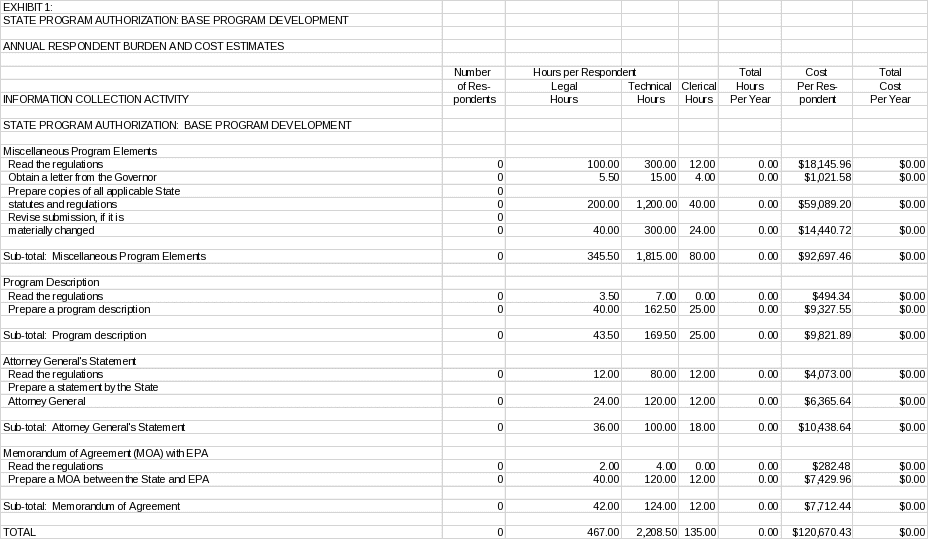
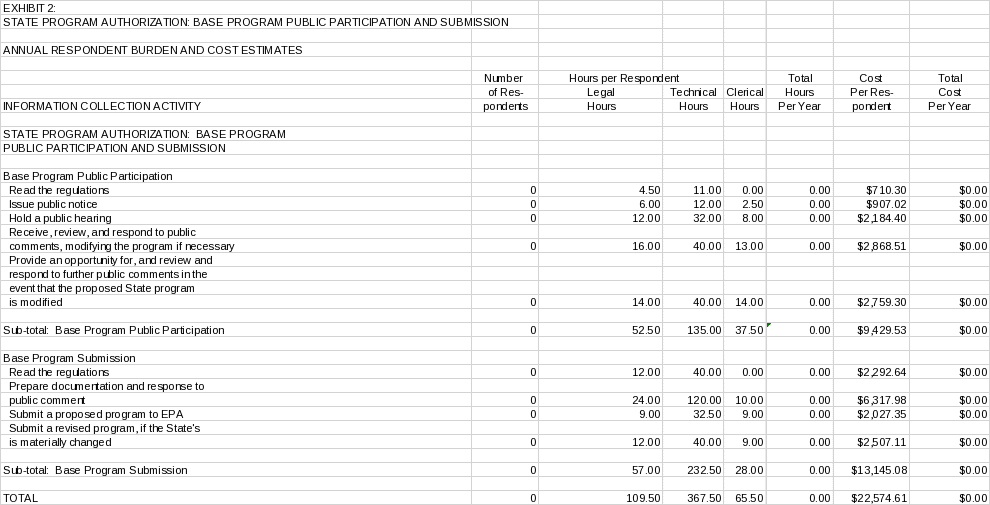
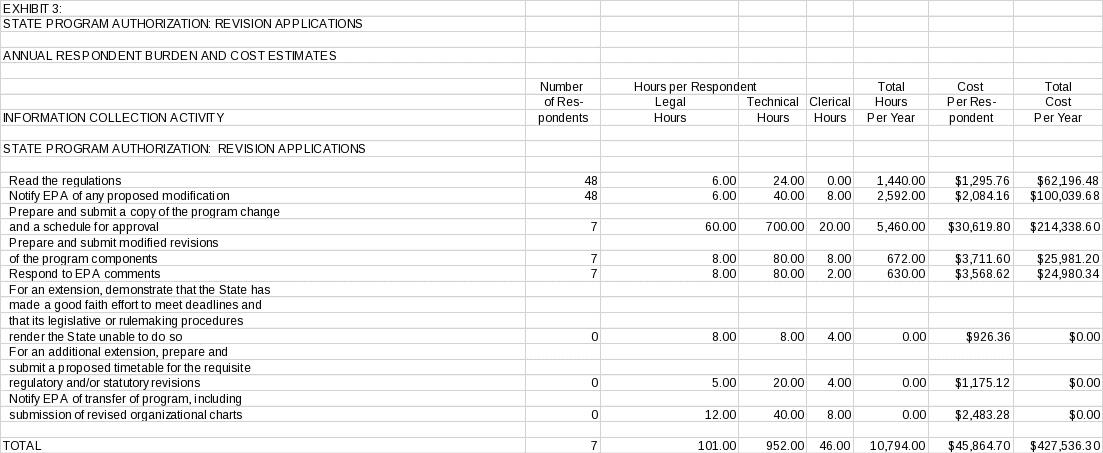
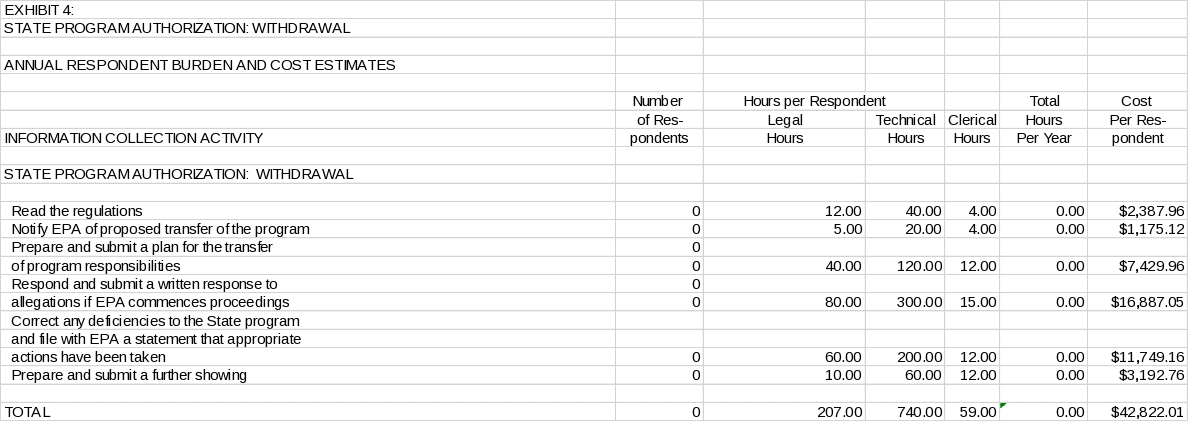

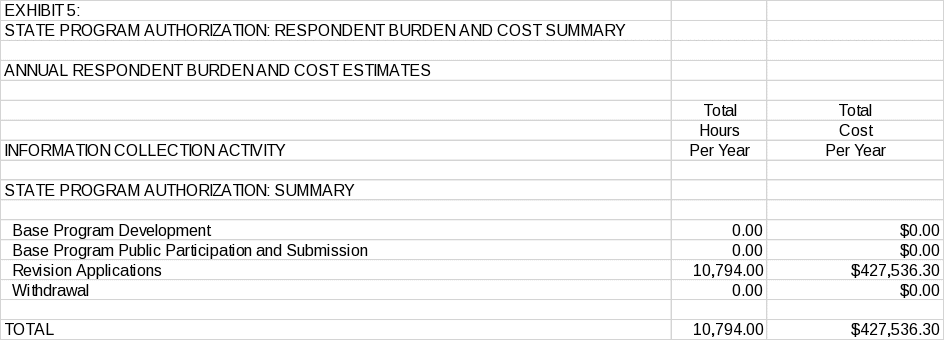
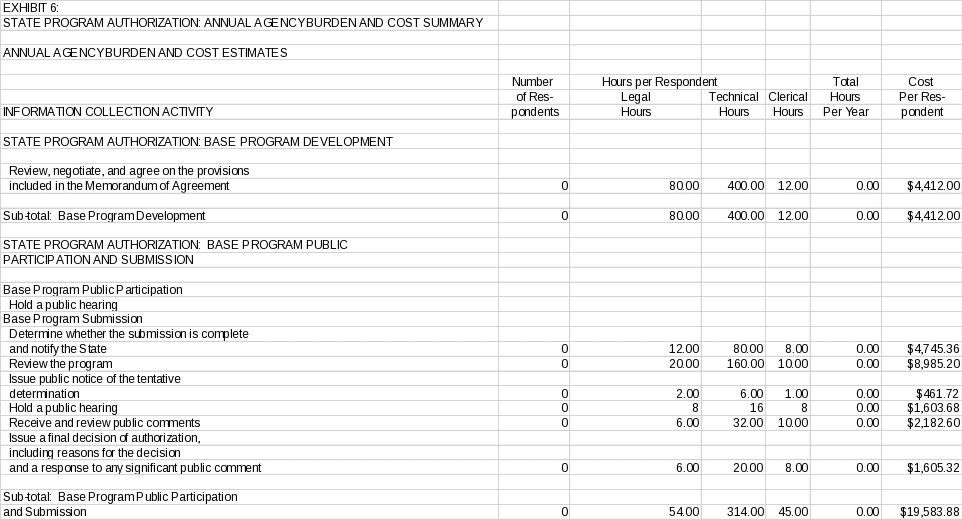
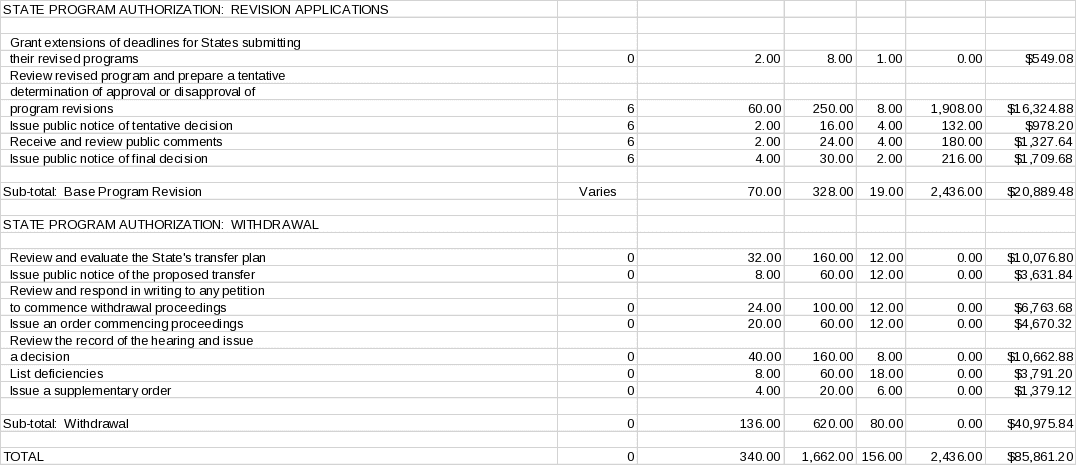
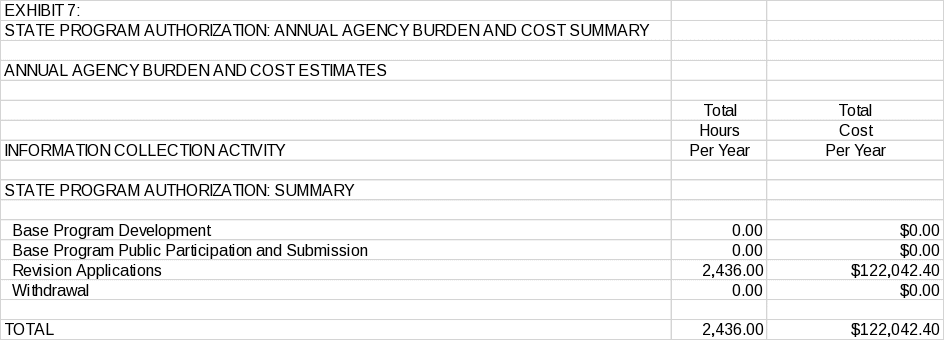
| File Type | application/vnd.openxmlformats-officedocument.wordprocessingml.document |
| Author | EPA |
| File Modified | 0000-00-00 |
| File Created | 2022-03-28 |
© 2025 OMB.report | Privacy Policy